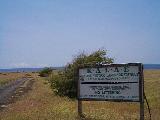| The road to south point is some 7 miles west of the village of Naalehu and then you turn off the main circum-island highway 11 and go south for another 20 some miles. There to greet you will be tourists like yourself and pockets of locals with time to talk story and fish all day. This is the southernmost point in the USA and the point fabled to be that first reached by the Tahitians who over time became Hawaiians. This is speculation, however, based on the fact that if you are coming from Tahiti, the first island you are likely to see is the Big Island because of the 14,000 foot mountains and then because this south point would be the closest landfall. (pictures taken March, 2001) |
